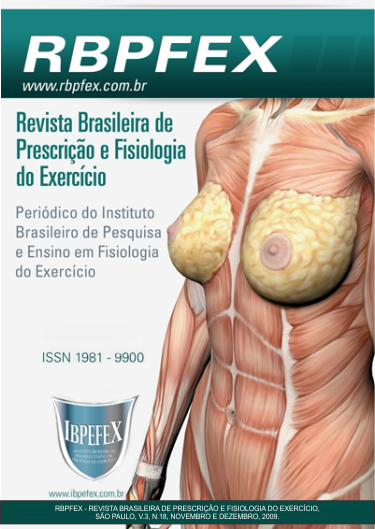Effect hypotension after aerobic exercise and resistance training and normotensive individuals
Abstract
After several studies, it's known that physical exercise promotes a hypotension after exercise, becoming an important procedure in the treatment and even in preventing non-pharmacological blood pressure both in normotensive and in hypertensive individuals. This study has shown the analysis and verify the values of systolic blood pressure (SBP) and diastolic (DBP) after aerobic exercise and endurance. The study, conducted with seven individuals with normal males, physically active, SEM: 118 ± 8mmhg SBP and DBP 80 ± 0mmhg. Were carried out two separate exercises, aerobic exercise, with 25 minutes in ergometric treadmill with 70% of heart rate training (FCT) and exercise endurance at 60% of 1RM, and performed as a circuit, using seven years, divided into members upper and lower. Blood pressure and heart rate were measured before exercise, immediately after and every 10 minutes in a period of 60 minutes, and blood pressure measured by the auscultatory method and heart rate monitor with heart rate. We observed a reduction in SBP and DBP after exercise in relation to pre-exercise, presented a reduction of the PA from 30 ° in the minutes of aerobic exercise and from 50 minutes in exercise endurance.
References
- Bennet, T.; Wilcox, R.G.; MacDonald, L.A. Post-exercise reduction of blood pressure in hypertensive men is not due to acute impairment of baroreflex function. Clinical Science. Num. 67. 1984. p. 97-103.
- Kaufman, F.L.; Hughson, R.L.; Schaumann, J.P. Effect of exercise on recovery blood pressure in normotensive and hipertensive subjects. Medicine Science in Sports & Exercise. Vol. 19. Num. 1. 1987. p. 17-20.
- Pescatello, L.S.; Fargo, A.E.Jr.; Leach, C.N.; e colaboradores. Short – Term effect of dynamic on exercise on arterial blood pressure. Circulation. Vol. 83. Num. 5. 1991. p. 1557-1561.
- Forjaz, C.L.M.; Mion Jr. D.; Negrão, C.E. The fall in blood pressure following a single bout of endurance exercise is sustains for 24 hours (Abstract). Hypertension. Num. 25. 1995. p. 1400.
- Forjaz, C.L.M.; Matsudaria, Y.; Rodrigues, F.B.; e colaboradores. Post exercise change in blood pressure heart rate and rate pressure product at different exercise intensities in normotensive humans. Brazilian Journal of Medical and Biological Research. Vol. 31. Num. 10. 1998. p. 1247-1255.
- Forjaz, C.L.M.; Santaella, D.F.; Rezende, L.O.; e colaboradores. A duração do exercício determina a magnitude e duração da hipotensão pós-exercício. Arquivos Brasileiro de Cardiologia. Vol. 70. Num. 2. 1998. p. 99-104.
- Kenney, M.J.; Seals, D.R. Post exercise hypertension key features, mechanisms and clinical significance. Hypertension. Vol. 22. Num. 5. 1993. p. 653-654.
- MacDonald, J.R.; Hogben, C.D.; Tarnopolsky, M.A.; Macdougall, D.J. Post exercise hypotension is sustained during subsequent bouts of mild exercise and simulated activities of daily living. Journal Human Hypertension. Vol. 15. Num. 8. 2001. p. 567.
- Polito, M.; Simão, R.; Senna, G.; Farinatti, P. Efeito hipotensivo do exercício de força realizado em intensidades diferentes e no mesmo volume de trabalho. Revista Brasileira de Medicina do Esporte. Vol. 9. Num. 2. Mar/Abr. 2003. p. 69-73.
- Lizardo, F.H.J.; Simões, G.H. Efeitos de diferentes sessões de exercício resistido sobre a hipotensão pós-exercício. Revista Brasileira de Fisioterapia. Vol. 9. Num. 3. 2005. p. 249-255.
- Arsa, G.C.; Rios, A.C.S.; Moreno, J.R.; Braga, P.L.; Campbell, C.S.G.; Simões, G.H. Hipotensão pós-exercício em hipertensos submetidos ao exercício aeróbio de intensidades variadas e de intensidades constantes. Revista Brasileira de Ciência e Movimento, Vol. 13. p. 261, suplemento, 2005.
- Negrão, C.E.; Rondon, M.U.P.B. Exercício físico, Hipertensão e controle barorreflexo da pressão arterial. Revista Brasileira de Hipertensão. Vol. 8. Num. 1. jan-mar 2001. p. 89-95.
- Duncan, J.J.; Farr, F.E.; Upton, S.J.; Hagan, R.D.; Oglesby, M.E.; Blair, S.N. The effects of aerobic exercise on plasma catecholamine’s and blood pressure in patients with mild essential hypertension. Jama. Vol. 254. Num. 18. 1985. p. 2609-2613.
- Brum, P.C.; da Silva, G.J.; Moreira, E.D.; Ida, F.; Negrão, C.E.; Krieger, E.M. Exercise training increases baroreceptor gain sensitivity in normal and hypertensive rats. Hypertension. Vol. 36. Num. 6. 2000. p. 1018-1022.
- MacDonald, J.R.; Macdougall, J.D.E.; Hogben, D.C. The effects of exercise duration on post-exercise hypotension. Journal of Human Hypertension. Vol. 14. 2000. p.125-129.
- Da Cunha, G.A.; Rios, A.C.S.; Moreno, J.R.; Braga, P.L.; Campbel, C.S.G.; Simões, H.G.; Denadai, M.L. Hipotensão pós-exercício em hipertensos submetidos ao exercício aeróbio de intensidades variadas e exercício de intensidades constante. Revista Brasileira de Medicina e Esporte. Vol. 12. Num. 6. nov/dez 2006. p. 313-317.
- Halliwill, J.R.; Taylor. J.A.; Eckberg. D.L. Impaired sympathetic vascular regulation in humans after acute dynamic exercise. Journal of Physiology. Vol. 491. Num. 1. Agosto 1996. p.278-288.
- Maiorana, A.; O’Driscoll, G.; Taylor, R.; Green, D. Exercise and the nitric oxide vasodilator system. American Journal Sports Medicine. Vol. 33. Num. 14. 2003. p.1013-1035.
- Attinà, T.M.; Malatino, L.S.; Maxwell, S.R.; Padfield, P.L.; Webb, D.J. Phosphodiesterase type 5 inhibition reverses impaired forearm exercise-induced vasodilatation in hypertensive patients. Journal of Hypertension. Vol. 26. Num. 3. 2008. p. 501-507.
- Halliwil, J.R. Mechanisms and clinical implications of post-exercise hypotension in humans. Exercise and Sport Sciences Reviews, Apr. Vol. 29. Num. 2. 2001. p. 65-70.
Authors who publish in this journal agree to the following terms:
- Authors retain the copyright and grant the journal the right of first publication, with work simultaneously licensed under the Creative Commons Attribution License BY-NC which allows the sharing of the work with acknowledgment of the authorship of the work and initial publication in this journal.
- Authors are authorized to enter into additional contracts separately for non-exclusive distribution of the version of the work published in this journal (eg, publishing in institutional repository or book chapter), with acknowledgment of authorship and initial publication in this journal.
- Authors are allowed and encouraged to post and distribute their work online (eg, in institutional repositories or on their personal page) at any point before or during the editorial process, as this can bring about productive change as well as increase impact and impact. citation of published work (See The Effect of Free Access).






